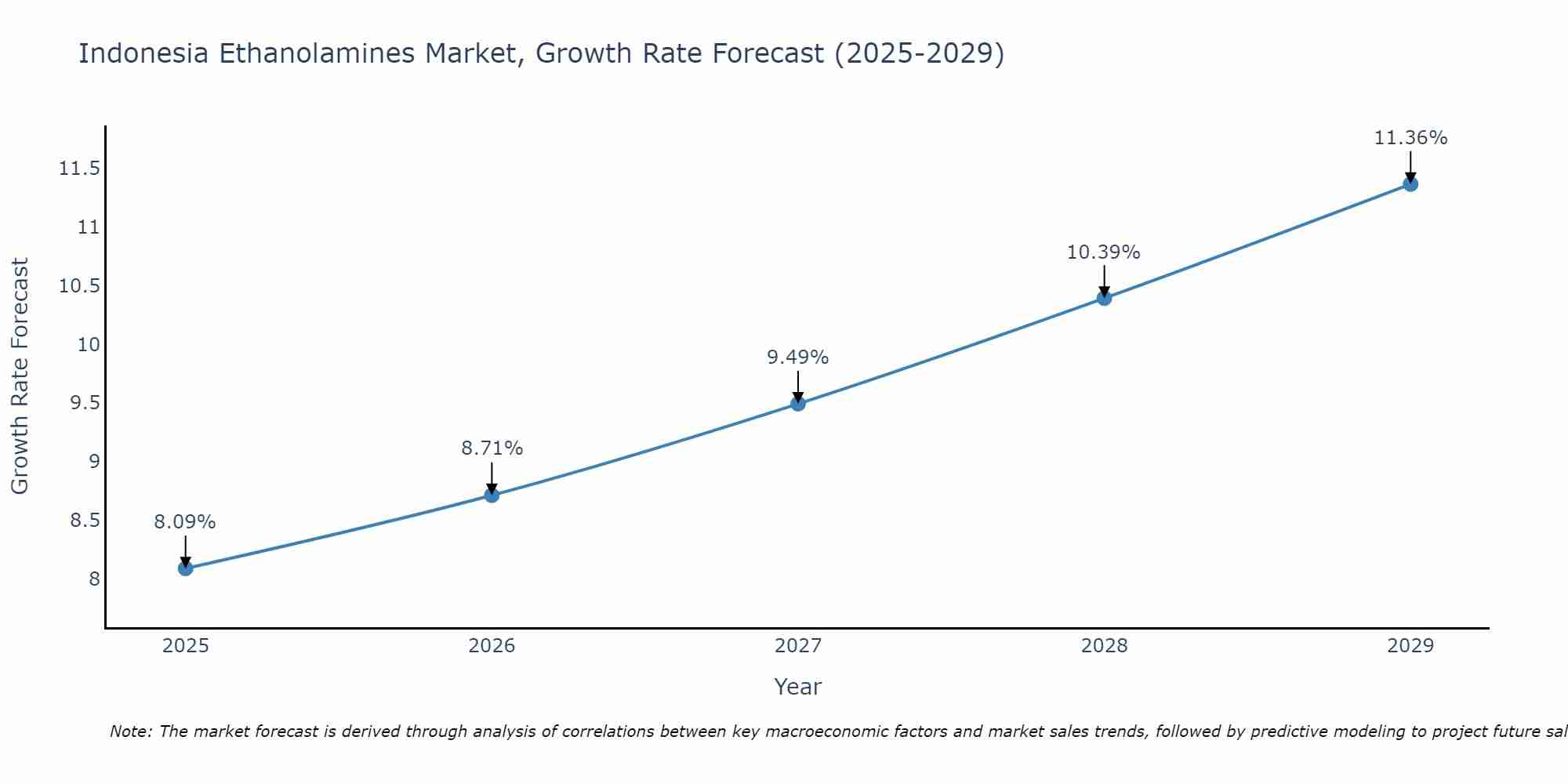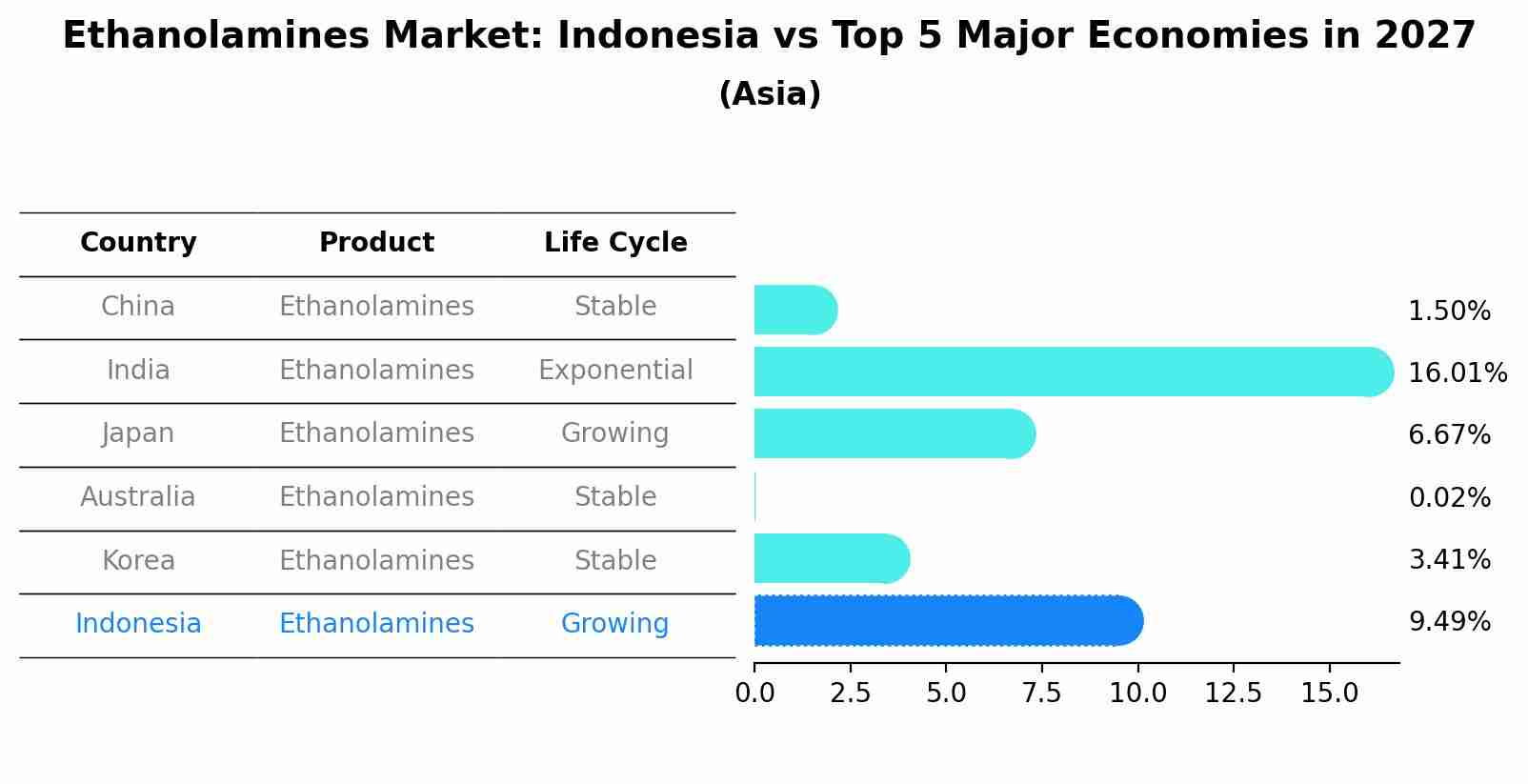Indonesia Ethanolamines Market (2025-2031) Outlook | Forecast, Industry, Trends, Analysis, Growth, Share, Companies, Revenue, Value & Size
| Product Code: ETC093527 | Publication Date: Jul 2023 | Updated Date: Apr 2025 | Product Type: Report | |
| Publisher: 6Wresearch | No. of Pages: 70 | No. of Figures: 35 | No. of Tables: 5 | |
Indonesia Ethanolamines Market Size Growth Rate
The Indonesia Ethanolamines Market is poised for steady growth rate improvements from 2025 to 2029. Commencing at 8.09% in 2025, growth builds up to 11.36% by 2029.

Ethanolamines Market: Indonesia vs Top 5 Major Economies in 2027 (Asia)
In the Asia region, the Ethanolamines market in Indonesia is projected to expand at a growing growth rate of 9.49% by 2027. The largest economy is China, followed by India, Japan, Australia and South Korea.

Indonesia Ethanolamines Market Synopsis
Indonesia is one of the major markets for ethanolamines, owing to its increasing demand from various end-use industries. Ethanolamines are used in a wide range of applications such as cleaning and degreasing agents, solvents, emulsifiers, corrosion inhibitors and surfactants. The growing demand for these products from different sectors such as agriculture, pharmaceuticals and cosmetics has contributed substantially to the growth of the Indonesia market for ethanolamines.
Market Trends
The increasing use of bioethanolamine due to environmental awareness among consumers has been driving the global ethanolamines market growth in Indonesia. This type of product is produced by breaking down natural sources into simple forms which can be used in multiple industries. Furthermore, manufacturers have been focusing on launching new innovative products with better performance features that allow them to gain competitive advantage over their competitors. For instance, US based Huntsman Corporation launched amino ether sulfate?based cold water detergents designed specifically for textile industry which improves wetting & leveling properties while providing high wash efficiency at low concentrations levels thus making it energy efficient when compared to traditional ethylene oxide-based detergents.. Moreover, rising trend towards green chemistry technology is also anticipated to provide ample opportunities across this region during forecast period (2025-2031).
Market Drivers
The rising demand from industrial sector coupled with growing consumer preference towards organic products have been driving the growth of Indonesia market for ethanolaminess considerably over past few years. Growing automotive industry along with expanding manufacturing sector has further boosted up consumption rates across Indonesia particularly in Jakarta region where majority automobile companies have set up their production units resulting into increased requirements for associated chemicals including ethanolaminesses. In addition government policies promoting foreign investments along with supportive tax regulations pertaining import-export activities have positively influenced trade dynamics thereby fuelling overall business operations throughout country?s landscape over past few years.
COVID-19 Impact on the Market
The Indonesia ethanolamines market is expected to witness a moderate decline in revenue growth during the forecast period due to the disruption of supply chains caused by COVID-19. Due to global pandemic, there has been a decrease in demand from various sectors such as automotive, construction, and other industrial applications that consume ethanalamines. Moreover, domestic production was also affected due to lockdown imposed across different provinces which created an imbalance between supply and demand of ethanalamines.
Challenges of the Market
The major challenge for ethanolamines manufacturers in Indonesia is meeting stringent regulations regarding their product quality set by both local governments as well as international organizations like European Union (EU). Additionally, fluctuations in raw material prices such as methanol and ammonia have resulted into increased cost for production resulting reduced profit margins. This further creates difficulty for new entrants planning to join this industry.
Industry Key Players
Some of the key players operating in Indonesia Ethanolamine Market are PT Agung Sepatu Raya (Indonesia), PT Anugerah Industri Kimia Sejahtera (Indonesia), PT Petra Mas Chemicals Industries (Indonesia), Sanyo Chemical Industries Ltd.(Japan) GEO Specialty Chemicals Inc.(US) Akzo Nobel N.V.(Netherlands) BASF SE (Germany).
Key Highlights of the Report:
- Indonesia Ethanolamines Market Outlook
- Market Size of Indonesia Ethanolamines Market, 2024
- Forecast of Indonesia Ethanolamines Market, 2031
- Historical Data and Forecast of Indonesia Ethanolamines Revenues & Volume for the Period 2021-2031
- Indonesia Ethanolamines Market Trend Evolution
- Indonesia Ethanolamines Market Drivers and Challenges
- Indonesia Ethanolamines Price Trends
- Indonesia Ethanolamines Porter's Five Forces
- Indonesia Ethanolamines Industry Life Cycle
- Historical Data and Forecast of Indonesia Ethanolamines Market Revenues & Volume By Type for the Period 2021-2031
- Historical Data and Forecast of Indonesia Ethanolamines Market Revenues & Volume By Monoethanolamine (MEA) for the Period 2021-2031
- Historical Data and Forecast of Indonesia Ethanolamines Market Revenues & Volume By Diethanolamine (DEA) for the Period 2021-2031
- Historical Data and Forecast of Indonesia Ethanolamines Market Revenues & Volume By Triethanolamine (TEA) for the Period 2021-2031
- Historical Data and Forecast of Indonesia Ethanolamines Market Revenues & Volume By Application for the Period 2021-2031
- Historical Data and Forecast of Indonesia Ethanolamines Market Revenues & Volume By Herbicides for the Period 2021-2031
- Historical Data and Forecast of Indonesia Ethanolamines Market Revenues & Volume By Surfactants for the Period 2021-2031
- Historical Data and Forecast of Indonesia Ethanolamines Market Revenues & Volume By Chemicals for the Period 2021-2031
- Historical Data and Forecast of Indonesia Ethanolamines Market Revenues & Volume By Gas Treatment for the Period 2021-2031
- Historical Data and Forecast of Indonesia Ethanolamines Market Revenues & Volume By Cement for the Period 2021-2031
- Indonesia Ethanolamines Import Export Trade Statistics
- Market Opportunity Assessment By Type
- Market Opportunity Assessment By Application
- Indonesia Ethanolamines Top Companies Market Share
- Indonesia Ethanolamines Competitive Benchmarking By Technical and Operational Parameters
- Indonesia Ethanolamines Company Profiles
- Indonesia Ethanolamines Key Strategic Recommendations
Frequently Asked Questions About the Market Study (FAQs):
- Single User License$ 1,995
- Department License$ 2,400
- Site License$ 3,120
- Global License$ 3,795
Search
Related Reports
- ASEAN and Thailand Brain Health Supplements Market (2025-2031) | Strategy, Consumer Insights, Analysis, Investment Trends, Opportunities, Growth, Size, Share, Industry, Revenue, Segments, Value, Segmentation, Supply, Forecast, Restraints, Outlook, Competition, Drivers, Trends, Demand, Pricing Analysis, Competitive, Strategic Insights, Companies, Challenges
- ASEAN Bearings Market (2025-2031) | Strategy, Consumer Insights, Analysis, Investment Trends, Opportunities, Growth, Size, Share, Industry, Revenue, Segments, Value, Segmentation, Supply, Forecast, Restraints, Outlook, Competition, Drivers, Trends, Demand, Pricing Analysis, Competitive, Strategic Insights, Companies, Challenges
- Europe Flooring Market (2025-2031) | Outlook, Share, Industry, Trends, Forecast, Companies, Revenue, Size, Analysis, Growth & Value
- Saudi Arabia Manlift Market (2025-2031) | Outlook, Size, Growth, Trends, Companies, Industry, Revenue, Value, Share, Forecast & Analysis
- Uganda Excavator, Crane, and Wheel Loaders Market (2025-2031) | Strategy, Consumer Insights, Analysis, Investment Trends, Opportunities, Growth, Size, Share, Industry, Revenue, Segments, Value, Segmentation, Supply, Forecast, Restraints, Outlook, Competition, Drivers, Trends, Demand, Pricing Analysis, Competitive, Strategic Insights, Companies, Challenges
- Rwanda Excavator, Crane, and Wheel Loaders Market (2025-2031) | Strategy, Consumer Insights, Analysis, Investment Trends, Opportunities, Growth, Size, Share, Industry, Revenue, Segments, Value, Segmentation, Supply, Forecast, Restraints, Outlook, Competition, Drivers, Trends, Demand, Pricing Analysis, Competitive, Strategic Insights, Companies, Challenges
- Kenya Excavator, Crane, and Wheel Loaders Market (2025-2031) | Strategy, Consumer Insights, Analysis, Investment Trends, Opportunities, Growth, Size, Share, Industry, Revenue, Segments, Value, Segmentation, Supply, Forecast, Restraints, Outlook, Competition, Drivers, Trends, Demand, Pricing Analysis, Competitive, Strategic Insights, Companies, Challenges
- Angola Excavator, Crane, and Wheel Loaders Market (2025-2031) | Strategy, Consumer Insights, Analysis, Investment Trends, Opportunities, Growth, Size, Share, Industry, Revenue, Segments, Value, Segmentation, Supply, Forecast, Restraints, Outlook, Competition, Drivers, Trends, Demand, Pricing Analysis, Competitive, Strategic Insights, Companies, Challenges
- Israel Intelligent Transport System Market (2025-2031) | Strategy, Consumer Insights, Analysis, Investment Trends, Opportunities, Growth, Size, Share, Industry, Revenue, Segments, Value, Segmentation, Supply, Forecast, Restraints, Outlook, Competition, Drivers, Trends, Demand, Pricing Analysis, Competitive, Strategic Insights, Companies, Challenges
- Uganda Precast and Aggregate Market (2025-2031) | Strategy, Consumer Insights, Analysis, Investment Trends, Opportunities, Growth, Size, Share, Industry, Revenue, Segments, Value, Segmentation, Supply, Forecast, Restraints, Outlook, Competition, Drivers, Trends, Demand, Pricing Analysis, Competitive, Strategic Insights, Companies, Challenges
Industry Events and Analyst Meet
Our Clients
Whitepaper
- Middle East & Africa Commercial Security Market Click here to view more.
- Middle East & Africa Fire Safety Systems & Equipment Market Click here to view more.
- GCC Drone Market Click here to view more.
- Middle East Lighting Fixture Market Click here to view more.
- GCC Physical & Perimeter Security Market Click here to view more.
6WResearch In News
- Doha a strategic location for EV manufacturing hub: IPA Qatar
- Demand for luxury TVs surging in the GCC, says Samsung
- Empowering Growth: The Thriving Journey of Bangladesh’s Cable Industry
- Demand for luxury TVs surging in the GCC, says Samsung
- Video call with a traditional healer? Once unthinkable, it’s now common in South Africa
- Intelligent Buildings To Smooth GCC’s Path To Net Zero













